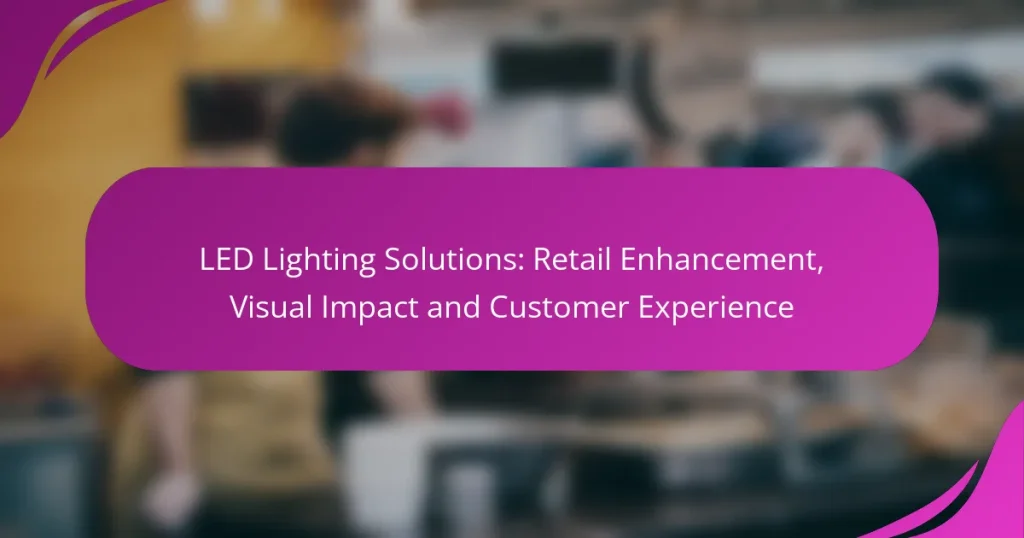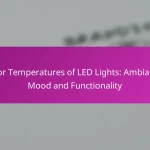LED lighting solutions play a crucial role in enhancing retail environments by improving product visibility and creating an inviting atmosphere that attracts customers. With their energy efficiency and long lifespan, LEDs not only reduce operational costs but also elevate the overall shopping experience, making them an ideal choice for retailers. By strategically implementing various types of LED lighting, such as track, accent, and ambient lighting, businesses can significantly boost their visual impact and customer engagement.
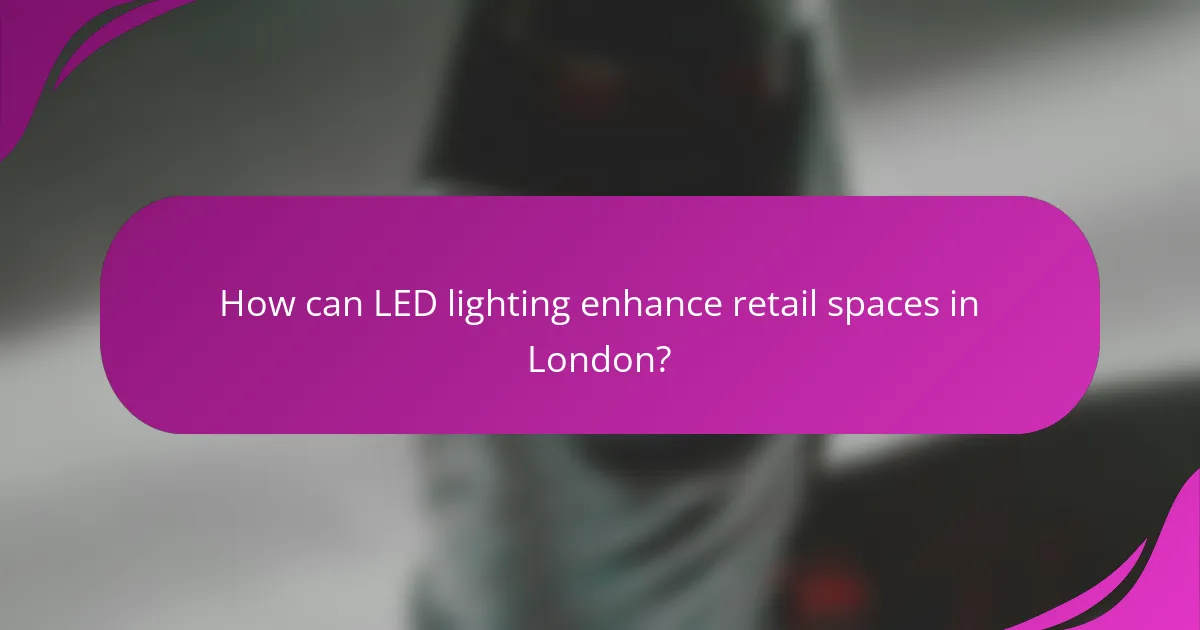
How can LED lighting enhance retail spaces in London?
LED lighting can significantly enhance retail spaces in London by improving product visibility, attracting more foot traffic, and fostering customer engagement. By utilizing energy-efficient and versatile lighting solutions, retailers can create an inviting atmosphere that encourages shopping and increases sales.
Improved product visibility
LED lighting enhances product visibility by providing bright, focused illumination that highlights merchandise effectively. This type of lighting can accentuate colors and textures, making products more appealing to customers. Retailers should consider using adjustable LED fixtures to direct light precisely where it’s needed, ensuring that key items stand out.
Additionally, LED lights have a longer lifespan and lower heat output compared to traditional bulbs, reducing maintenance costs and minimizing the risk of damaging sensitive products. For optimal results, a combination of ambient, task, and accent lighting can be employed to create a well-lit shopping environment.
Increased foot traffic
Attractive LED lighting can draw more customers into retail spaces by creating a welcoming and vibrant atmosphere. Bright, well-lit storefronts are more likely to catch the attention of passersby, especially in busy areas of London. Retailers can use dynamic lighting displays to create eye-catching window presentations that entice potential shoppers.
Furthermore, strategic placement of LED lights in key areas, such as entrances and pathways, can guide customers through the store, encouraging them to explore more products. Retailers should regularly assess their lighting setup to ensure it remains fresh and engaging.
Enhanced customer engagement
LED lighting can enhance customer engagement by creating an immersive shopping experience that resonates with the brand’s identity. By using color-changing LEDs or programmable lighting systems, retailers can set different moods or themes that align with seasonal promotions or events. This adaptability can keep the shopping experience exciting and relevant.
Moreover, well-lit spaces can encourage customers to linger longer, increasing the likelihood of purchases. Retailers should consider incorporating interactive lighting elements, such as motion sensors that change lighting based on customer movement, to further enhance engagement and create a memorable shopping experience.

What are the benefits of LED lighting for retail?
LED lighting offers numerous advantages for retail environments, enhancing visual appeal and improving customer experience. Key benefits include energy efficiency, a long lifespan, and significant cost savings, making LEDs an ideal choice for retailers looking to optimize their lighting solutions.
Energy efficiency
LED lighting is highly energy-efficient, consuming up to 80% less electricity than traditional incandescent bulbs. This efficiency translates into lower energy bills, which is particularly beneficial for retailers operating large spaces with extended operating hours.
Additionally, LEDs produce less heat compared to conventional lighting, reducing the need for air conditioning in retail settings. This can further decrease energy costs and improve overall comfort for customers and staff alike.
Long lifespan
LED lights have an impressive lifespan, often lasting 15,000 to 50,000 hours, significantly longer than traditional bulbs. This longevity means less frequent replacements, which can reduce maintenance efforts and costs for retailers.
Choosing LED lighting can minimize disruptions caused by burnt-out bulbs, ensuring that stores maintain a consistently inviting atmosphere. Retailers can focus on customer service rather than lighting upkeep.
Cost savings
While the initial investment in LED lighting may be higher than traditional options, the long-term cost savings are substantial. Retailers can expect reduced energy bills and lower replacement costs due to the extended lifespan of LEDs.
Moreover, many regions offer incentives or rebates for businesses that switch to energy-efficient lighting, further offsetting initial expenses. Retailers should explore local programs to maximize their savings when transitioning to LED lighting solutions.
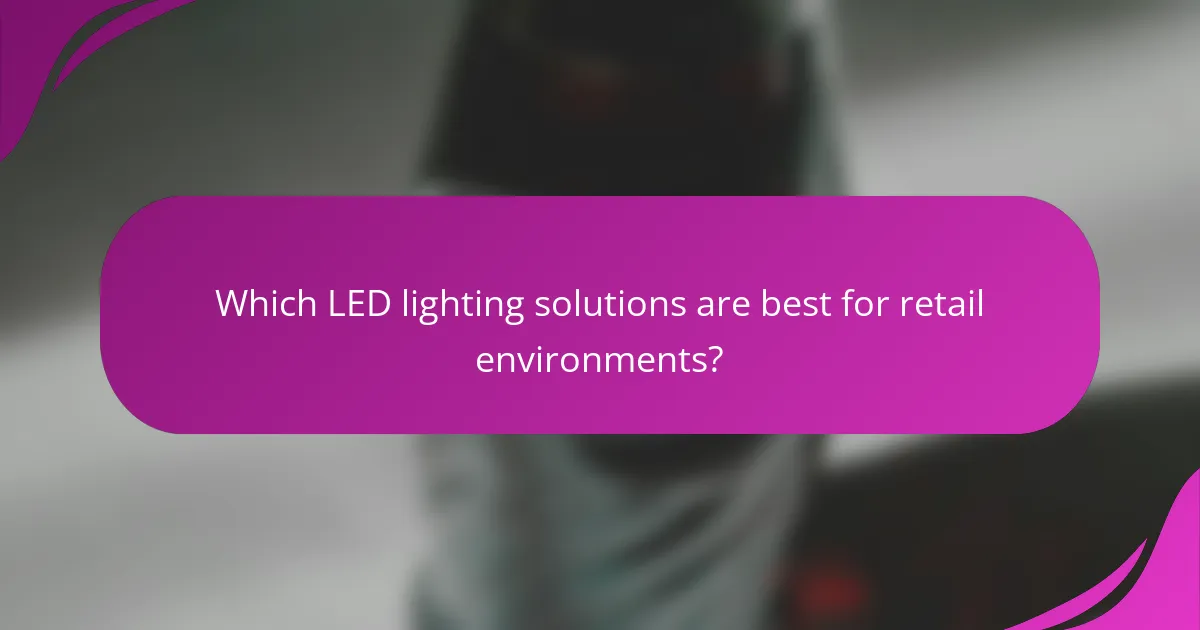
Which LED lighting solutions are best for retail environments?
The best LED lighting solutions for retail environments include track lighting, accent lighting, and ambient lighting. Each type serves a unique purpose, enhancing product visibility and improving the overall shopping experience.
Track lighting
Track lighting is a versatile option that allows retailers to direct light precisely where it’s needed. It consists of multiple fixtures mounted on a single track, enabling easy repositioning to highlight specific products or areas.
When implementing track lighting, consider the layout of your store and the types of products you want to showcase. Use adjustable fixtures to create focal points and enhance visual interest. A common approach is to use warm white LEDs to create an inviting atmosphere.
Accent lighting
Accent lighting is designed to draw attention to specific items, creating visual interest and enhancing product appeal. This type of lighting is typically brighter than ambient lighting and can be achieved through spotlights or wall-mounted fixtures.
To effectively use accent lighting, focus on key merchandise displays or promotional areas. A good rule of thumb is to use accent lights that are at least three times brighter than the surrounding ambient light. This contrast helps products stand out and encourages customer engagement.
Ambient lighting
Ambient lighting provides overall illumination in a retail space, ensuring that customers can navigate comfortably. It sets the mood and enhances the shopping experience without overwhelming the senses.
For ambient lighting, consider using LED ceiling fixtures or recessed lighting to create a soft, even glow. Aim for a color temperature between 3000K and 4000K for a warm yet vibrant atmosphere. Avoid harsh shadows and ensure uniform light distribution to maintain a welcoming environment.

How to choose the right LED lighting for your store?
Choosing the right LED lighting for your store involves understanding the store layout, selecting appropriate color temperatures, and assessing brightness levels. These factors significantly influence customer experience and product visibility, ultimately affecting sales.
Consider store layout
Your store layout directly impacts how lighting should be configured. For example, open floor plans may benefit from uniform lighting to create an inviting atmosphere, while segmented areas might require focused lighting to highlight specific products.
Think about the flow of customer traffic as well. Placing brighter lights in high-traffic areas can draw attention to promotions or featured items, while softer lighting in quieter sections can create a more relaxed shopping environment.
Evaluate lighting color temperature
Color temperature, measured in Kelvin (K), affects how products appear and the overall ambiance. Warmer temperatures (around 2700K to 3000K) create a cozy feel, ideal for clothing or home goods, while cooler temperatures (4000K to 5000K) are better for electronics or food items, enhancing clarity and detail.
Consider the psychological effects of color temperature as well. Warmer lights can encourage customers to linger, while cooler lights can energize and stimulate quicker purchasing decisions.
Assess brightness levels
Brightness, measured in lumens, should be tailored to the specific needs of your store. A general guideline is to aim for around 300-500 lumens per square meter for retail spaces, but this can vary based on product type and display style.
Be cautious of over-illumination, which can create glare and discomfort. Instead, focus on achieving a balanced lighting scheme that enhances product visibility without overwhelming customers. Regularly assess and adjust lighting as needed to maintain an inviting shopping environment.
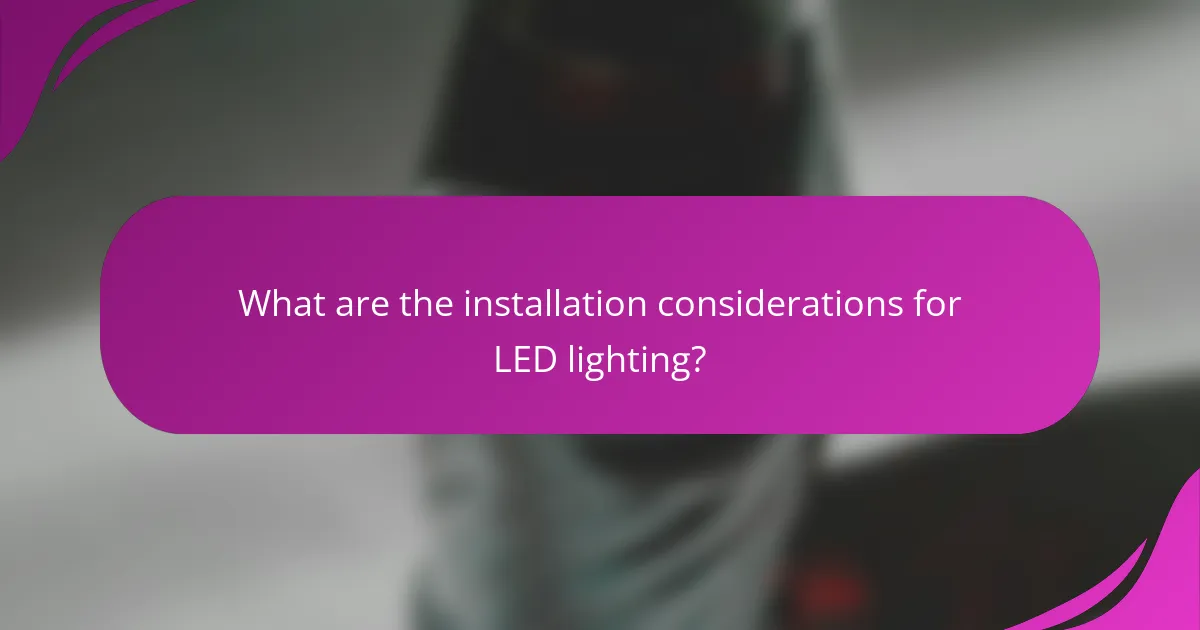
What are the installation considerations for LED lighting?
When installing LED lighting, key considerations include the choice of fixtures, power supply compatibility, and the layout of the space. Proper installation ensures optimal performance and energy efficiency, enhancing both aesthetics and functionality in retail environments.
Professional installation services
Utilizing professional installation services can significantly improve the quality and safety of LED lighting setups. Experts can assess the specific needs of a retail space, ensuring that the lighting design aligns with the overall branding and customer experience goals.
Hiring professionals also helps avoid common pitfalls, such as incorrect wiring or inadequate fixture placement. This can lead to improved energy efficiency and reduced maintenance costs over time.
Compliance with local regulations
Compliance with local regulations is crucial when installing LED lighting. Many regions have specific codes regarding energy efficiency, safety standards, and environmental impact that must be adhered to during installation.
Before proceeding, check local building codes and energy regulations to ensure that your LED lighting solutions meet all necessary requirements. This can prevent costly fines and ensure a smoother installation process.
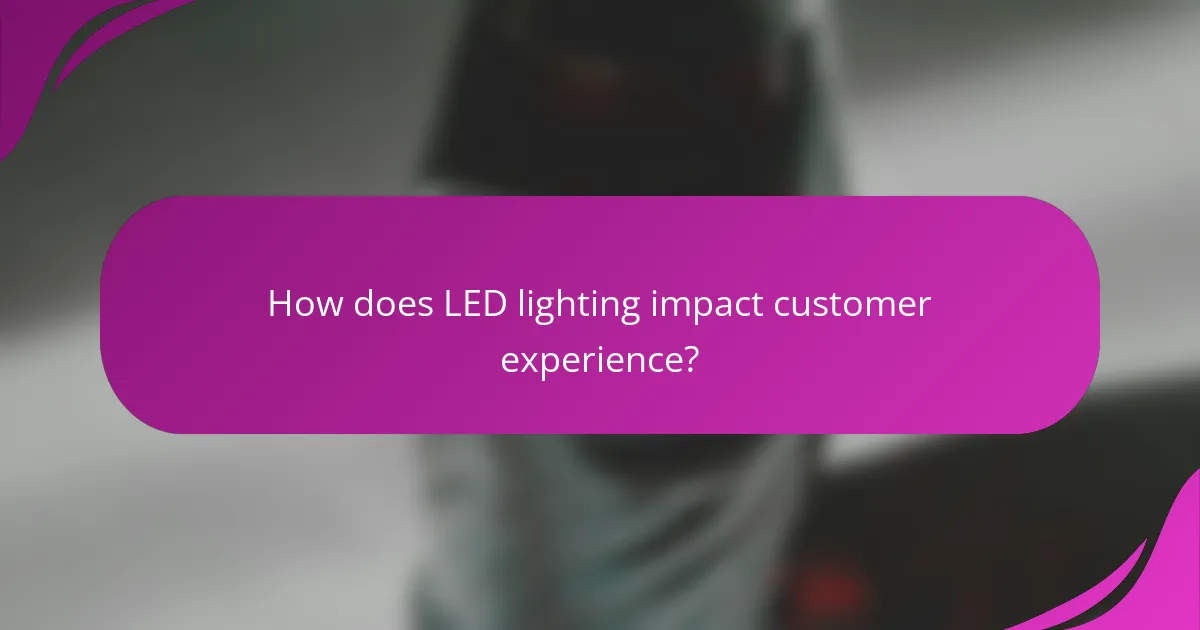
How does LED lighting impact customer experience?
LED lighting significantly enhances customer experience by creating an inviting environment and influencing buying behavior. Its energy efficiency and versatility allow retailers to design spaces that not only attract customers but also encourage longer visits and increased sales.
Creates a welcoming atmosphere
LED lighting can transform a retail space into a warm and inviting environment. By using adjustable color temperatures, retailers can create a cozy ambiance that makes customers feel comfortable and relaxed. For instance, warmer tones are often more appealing in clothing stores, while cooler tones may work better in tech shops.
Additionally, strategic placement of LED fixtures can highlight key areas, such as entranceways or product displays, enhancing the overall aesthetic. This visual appeal can lead to a more enjoyable shopping experience, encouraging customers to spend more time in the store.
Influences purchasing decisions
The right LED lighting can significantly sway purchasing decisions by drawing attention to products and creating a sense of urgency. Bright, focused lighting can make items appear more attractive, while softer lighting can enhance the perceived quality of premium products. Retailers should consider using accent lighting to spotlight high-margin items.
Moreover, studies suggest that well-lit displays can increase sales by a notable percentage. Retailers should regularly assess their lighting strategies, ensuring that they align with current trends and customer preferences to maximize impact.
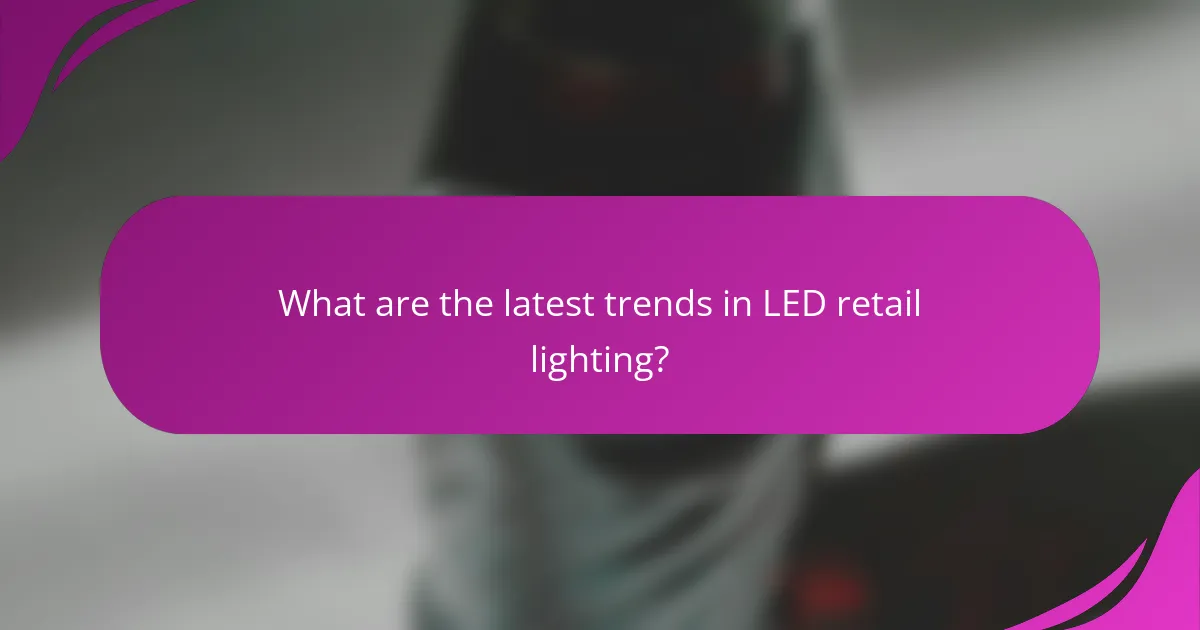
What are the latest trends in LED retail lighting?
The latest trends in LED retail lighting focus on enhancing customer experiences and visual merchandising through innovative technologies and designs. Retailers are increasingly adopting energy-efficient solutions that not only reduce costs but also create engaging environments that attract and retain customers.
Smart lighting technology
Smart lighting technology integrates LED systems with advanced controls, allowing for dynamic adjustments based on customer behavior and environmental conditions. This technology can include features such as motion sensors, timers, and remote management, enabling retailers to optimize lighting for energy savings and ambiance.
For example, a store might use smart lighting to brighten areas with high foot traffic during peak hours while dimming less frequented sections. This not only enhances the shopping experience but also reduces energy consumption, leading to lower operational costs.
When implementing smart lighting, consider compatibility with existing systems and the potential for future upgrades. Investing in scalable solutions can provide long-term benefits as technology continues to evolve.
